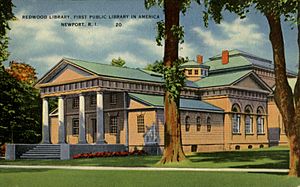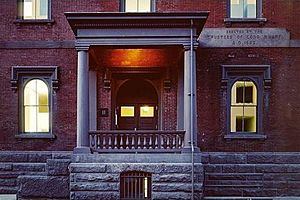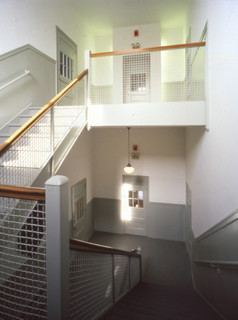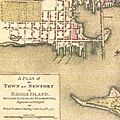John Callender (clergyman) facts for kids
Quick facts for kids
John Callender
|
|
|---|---|
| Born |
John Callender Jr.
1706 |
| Died | 1748 |
| Education | Harvard College A.B. 1726 |
| Known for | Clergyman, historian |
|
Notable work
|
pastor of the First Baptist Church in Newport, Rhode Island |
John Callender Jr. (1706–1748) was an American historian and a pastor, which is a leader in a Christian church. He served the First Baptist Church in Newport, Rhode Island. He wrote the very first history book about Rhode Island. Its long title was An Historical Discourse on the Civil and Religious Affairs of the Colony of Rhode-Island, in New England in America. From the First Settlement in 1638, to the end of the First Century.
Contents
Who Was John Callender Jr.?
His Early Life and Education
John Callender was born in 1706 in Boston, Massachusetts. His father was a shopkeeper. John was very smart from a young age. He started attending Harvard College when he was only 13 years old. At Harvard, he learned about the early Baptists in America.
The first president of Harvard College, Henry Dunster, was influenced by early Baptist leaders like Dr. John Clarke. Dunster even had to leave Harvard because he refused to baptize his own baby, which was a Baptist belief.
John Callender received a scholarship to Harvard. This help came from Thomas Hollis (1659–1731), who was a Baptist, and Thomas Brattle, who was the treasurer of Harvard College. When John graduated in 1726, he gave a special speech. The topic was that the Bible is the perfect and only rule for what we believe and how we act.
In 1726, John Callender was baptized by his uncle, Elisha Callender. His uncle was the pastor of the First Baptist Church in Boston. This church had also been led by John's grandfather, Ellis Callender. In 1727, John was given permission to preach. For a short time, he preached and taught school at the First Baptist Church in Swansea in Bristol County, Massachusetts.
His Work as a Church Leader
Until 1730, Callender worked as a pastor at a historic Baptist Church in Swansea, Massachusetts. After that, he moved to United Baptist Church (Newport, Rhode Island) in Newport, Rhode Island, where he stayed for the rest of his life. He officially became a pastor on October 13, 1731. His uncle, Elisha Callender, performed the ceremony.
John Callender's work in Newport from 1731 to 1748 was very important for the early history of the Baptist Church in North America. The Baptist Church in Newport was started by Roger Williams and John Clarke. They wanted to create a place where people could have religious freedom.
In 1638, Minister John Clarke was forced to leave Massachusetts because he disagreed with the Puritan leaders. He looked for a place where he could worship freely, and he found it in nearby Portsmouth, Rhode Island. By 1639, Roger Williams had started a Baptist church in Providence, Rhode Island. In 1640, John Clarke established a Baptist church in Newport, Rhode Island.
Getting Involved in the Community
Soon after moving to Newport, Rhode Island in 1731, John Callender became very interested in the public schools there. He also joined a special group called a philosophical and literary society. This was a club for people who loved to share ideas and collect valuable books. This group later became the Redwood Library and Athenaeum.
Many important people were part of this society. They included Bishop Berkeley, a famous thinker; Daniel Updike, the Attorney General of Rhode Island; and William Ellery, who later signed the Declaration of Independence. Even famous writer Samuel Johnson sometimes joined them.
The main goal of the society was to talk about ideas and gather important books. Many of these books are still kept in the oldest part of the Redwood Library today. The Redwood Library building was designed in 1750 by Peter Harrison. It is known as America's second oldest public library and one of its first important public buildings.
His Famous Book and Other Writings
An Historical Discourse...
John Callender is probably best known for his speech called An Historical Discourse on the Civil and Religious Affairs of the Colony of Rhode-Island. He gave this speech on March 24, 1738. It was the first history book ever written about Rhode Island.
This speech was also known as the "Century Sermon" because it marked 100 years since Rhode Island was settled. For over a hundred years, it was the only history book about Rhode Island's government and religious life. It was printed again in 1838 by the Rhode Island Historical Society.
Other Publications
Callender also published sermons, which are speeches given in church. He also put together a collection of documents about the history of Baptists in America.
In 1739, he published a sermon he gave when Mr. Jeremiah Condy became a pastor at the First Baptist Church in Boston. In 1791, a speech he wrote was published. It talked about how important it is for children to learn about religion early, so they can live lives filled with love and serve God. He also published a funeral sermon in 1745 and a piece called "The Hymn to the Power of Harmony" in 1763.
His Family and Passing
On February 15, 1730, John Callender married Elizabeth Hardin. They had six children: Elizabeth, Mary, John, Elias, Sarah, and Josias. John Callender Jr. passed away on January 26, 1748, after being sick for a long time. He is buried in the John Clarke Cemetery in Newport, Rhode Island.
His Legacy Today
John Callender (1706-1748) has a school named after him in Newport, Rhode Island. It's called Callender School and is in the historic Point section, also known as the "Easton's Point" neighborhood. This area has many old colonial houses.
In 1862, a beautiful school building was built on Willow Street. It was officially opened on May 20, 1863. The school was commissioned by a group called The Trustees of the Long Wharf. This group was formed in 1795 to rebuild the docks that were destroyed during the American Revolution.
In 1906, the school building was renamed Callender School. This was done to celebrate 200 years since John Callender's birth. The Callender School building is now listed on The National Register of Historic Places (NRHP), which means it's an important historical site.
Images for kids






